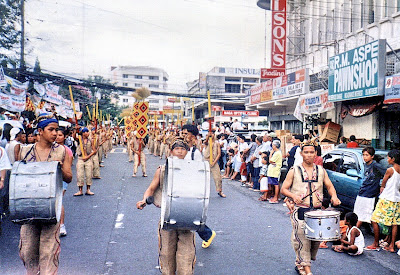 |
| Kawayanan Festival |
Throughout my 4-day stay in the town, I was kept busy by undertaking with gusto, the role of judge for four of the festivals’ competitions: the Bamboo Booth competition (maybe because of my being an architect), the Cookfest (my favorite pastime: eating that is, not cooking), the Street Dancing Competition and the In-Place Dance Competition (held at the gym). It seems that the only contest I didn’t judge was the Miss Gloria Tourism 2002 beauty contest. On my second day, to save on time, I did my bamboo booth and cookfest assignment at the same time. It was easier said than done. Midway through my assignment, my complexion turned from fair to really brown (like roasted lechon). However, the cookfest was a delight as I got to sample, mostly for the first time, the town’s labong cuisine, making it a point to sample each dish once in every booth. Of the present 22 bamboo varieties in town, only two (the first-class tinikan and bolo) are used for labong.
In succession, I tried the atsarang labong (Brgy. A. Bonifacio), embutidong labong (Brgy. Kawit), apritadang manok with labong (Brgy. Mirayan), fried lumpiang labong (Brgy. San Antonio), fresh lumpiang labong (Barangay Lucio Laurel), tortilla con labong (Brgy. Agsalin), guinataang labong, labong salad and bola-bolang labong. I also enjoyed the buko pandan and cassava chips, washing it all down with buko juice. So much for lunch (and dinner). I don’t recall what I sampled in Brgy. Guimbonan but she handily won the cookfest’s grand prize. Brgy. Malayong won the booth competition.
 |
| A daring bamboo stunt |
If the cookfest was a delight, the two dance competitions were spectacles by themselves. Costumes, musical instruments and props (including the bamboo galleon of Brgy. Lucio Laurel) used were all bamboo-inspired. What was truly spectacular was some of the choreography (to the beat of the latest dance music) which included some death defying stunts fit for a circus. Try balancing spread eagle on the tip of a bamboo pole using the pit of your stomach or try dancing on the top rungs of 3 1-storey high bamboo ladders held vertically together. I wouldn’t dare but they did. In the end, Brgy. Tambong won the Street Dancing Competition (with Narra second) and Brgy. Lucio-Laurel the In-Place Dancing Competition (with Maligaya second).
 |
| A bamboo galleon |
Gloria is a coastal town and beautiful black sand beaches facing the Tablas Strait extend from Barangays Tambong to Agsalin. Too bad there is no setting sun along this coast (Mindoro Oriental faces east). Just the same, the municipality is making efforts to develop resorts along this beautiful coast. Part of our itinerary was a visit to these resorts. They include El Primus Jose (Brgy. Tambong Punta), Villa Escober Beach Resort (Brgy. San Antonio) and Bighani Beach Resort and Mabuhay Beach Resort, both in Brgy. Giumbonan.
 |
| My first carabao ride |
On our last day, we had breakfast at the dining pavilion of Prima Farm Resort in Brgy. Bulaklakan. This rising star of a resort has so far finished 11 airconditioned cottages with bath and TV, all beautifully built with the town’s trademark bamboo in mind. Each are also named after one of the town’s 27 barangays and built accordingly by the barangay’s artisans. The resort intends to finish, in the near future, its complete roster of 27 cottages.











.jpg)






